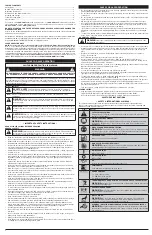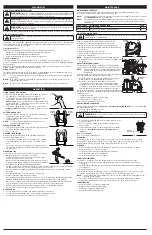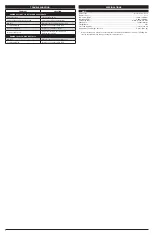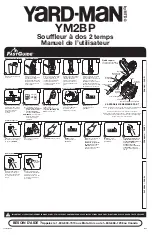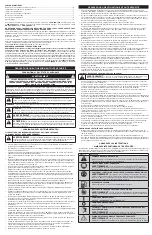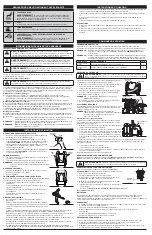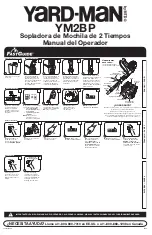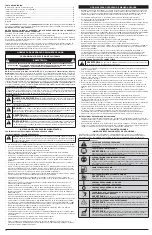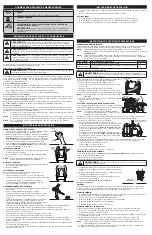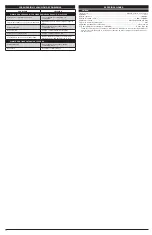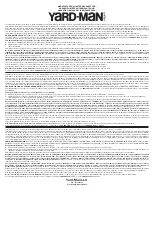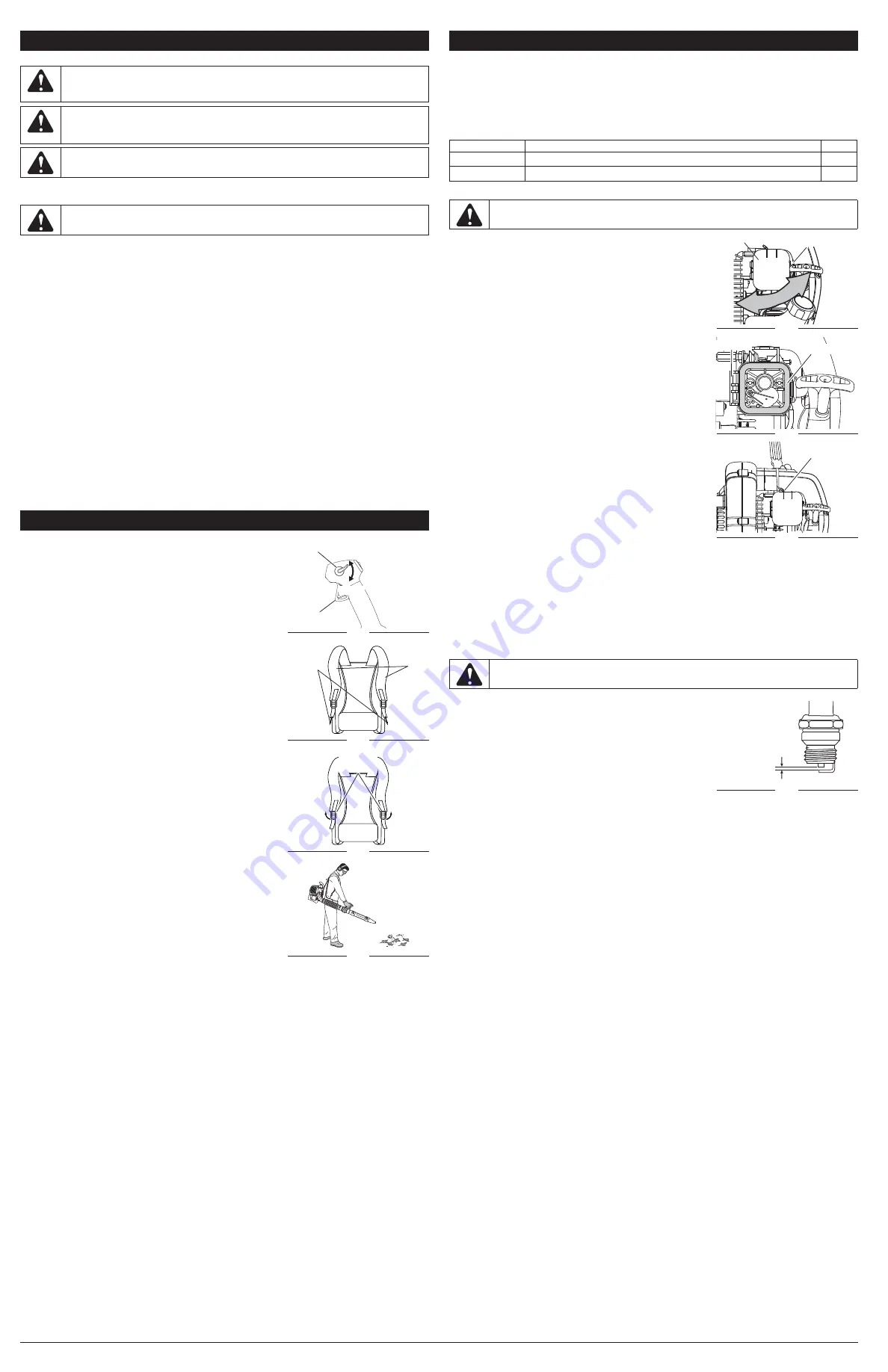
3
USING THE CRUISE CONTROL
1. Once the engine has been started and warmed up, squeeze
the trigger to accelerate the unit as needed (Fig. 1).
2. For longer periods of operation and to eliminate possible
fi nger fatigue, move the cruise control toward the
FAST position
to incrementally increase or maintain the unit’s
engine speed (Fig. 1). When the cruise control is pressed, the
trigger will recede into the handle.
3. To decrease engine speed, move the cruise control to the
SLOW position
and the trigger will return to the idle position
(Fig. 1).
PUTTING ON THE UNIT
1. Place the shoulder supports over the shoulders so that the
engine rests on the operator’s back.
2. Pull the shoulder support straps down to tighten the shoulder
supports (Fig. 2).
NOTE:
The unit must be started prior to putting it on. See
Starting/Stopping Instructions.
TAKING OFF THE UNIT
1. Pull up on the bottom tabs of the shoulder support buckles to
loosen the shoulder supports (Fig. 3).
2.
Remove the unit.
HOLDING THE BLOWER
Before operating the unit, stand in the operating position and
check for the following (Fig. 4):
•
The operator is wearing eye protection and proper clothing.
•
If the conditions are dusty, the operator is wearing a dust
mask.
•
The unit is secure and comfortable on the operator’s back.
•
The right arm is slightly bent and the right hand is gripping the
throttle control.
OPERATING TIPS
•
Never direct the unit at anyone while the unit is in operation.
•
Always hold the unit securely when operating.
•
To reduce the risk of hearing loss associated with sound
level(s), hearing protection is required.
•
Operate power equipment only at reasonable hours. Comply
with times listed in local ordinances. Usual recommendations
are 9:00 am to 5:00 pm, Monday through Saturday.
•
To reduce noise levels, operate power blowers at the lowest possible speed to do the job and limit
the total number of pieces of power equipment used at any one time.
•
Check unit before operating, especially muffl er, air intakes and air fi lters, for debri and possible
blockages.
•
Use rakes and brooms to loosen debris before blowing.
•
In dusty conditions, slightly dampen surfaces.
•
Conserve water by using power blowers instead of hoses for many lawn and garden applications,
including cleaning debri from areas such as screens, patios, grills, porches, and gardens.
•
Watch out for children, pets, open windows or freshly washed cars, and blow debris safely away.
•
Use the full blower nozzle extension so the air stream can work closer to the ground.
•
Clean up after using blowers and other equipment. Dispose of debris appropriately.
•
Use the cruise control to make continuous operation easier.
APPLICATIONS
•
Use the blower for trees, shrubs, fl ower beds and hard-to-clean areas.
•
Use the unit around buildings and for other normal cleaning procedures.
•
Use the blower around walls, overhangs, fences and screens.
OIL AND FUEL MIXING INSTRUCTIONS
Be sure to use fresh, clean unleaded fuel and follow instructions carefully for proper fuel/oil mixture.
Defi nition of Blended Fuels
Today’s fuels are often a blend of gasoline and oxygenates such as ethanol, methanol, or MTBE (ether)
which absorb water. Use fuel within 30 days of purchase. Blended fuels older than 30 days will affect
the performance and life of the engine.
Using Blended Fuels
If the use of blended fuel is unavoidable, follow recommended precautions:
•
Always use the fresh fuel mix explained in the operator’s manual
•
Always agitate the fuel mix before fueling the unit
•
Drain the tank and run the engine dry before storing the unit
Using Fuel Additives
It is recommended to use the manufacturers 2-cycle oil with this unit. If unavailable, use a good
2-cycle oil designed for air-cooled engines along with a fuel additive, such as STA-BIL® Gas Stabilizer
or an equivalent.
Add 0.8 oz. (23 ml.) of fuel additive per gallon of fuel according to the instructions on the container.
NEVER add fuel additives directly to the unit’s fuel tank.
Mixing The Fuel
Thoroughly mix the proper ratio of 2-cycle engine oil with unleaded fuel in a separate fuel can. Use a
40:1 fuel/oil ratio. Do not mix them directly in the engine fuel tank.
IF.
..
the unit came with a bottle of 2-cycle oil; pour the entire bottle into 1 gallon of gas and mix
thoroughly.
NOTE:
One gallon (3.8 liters) of unleaded fuel mixed with one 3.2 oz. (95 ml.) bottle of 2-cycle oil
makes a 40:1 fuel/oil ratio.
NOTE:
Dispose of the old fuel/oil mix in accordance to Federal, State and Local regulations.
OIL AND FUEL
WARNING:
Fuel containing greater than 10% ethanol will likely damage the engine and
void the warranty.
WARNING:
Gasoline is extremely fl ammable. Ignited vapors may explode. Always stop
the engine and allow it to cool before fi lling the fuel tank. Do not smoke while fi lling the
tank. Keep sparks and open fl ames at a distance from the area.
WARNING:
Remove fuel cap slowly to avoid injury from fuel spray. Never operate the unit
without the fuel cap securely in place.
WARNING:
Add fuel in a clean, level and well ventilated outdoor area. Wipe up any
spilled fuel immediately. Avoid creating a source of ignition for spilled fuel. Do not start the
engine until fuel vapors dissipate.
MAINTENANCE SCHEDULE
Perform these required maintenance procedures at the frequency stated in the table. These
procedures should also be a part of any seasonal tune-up.
NOTE:
Some maintenance procedures may require special tools or skills. For these types of repairs
call
1-800-800-7310
for more information.
NOTE:
Please read the California/ EPA statement that came with the unit for a complete listing of
terms and coverage for the emissions control devices, such as the spark arrestor, muffl er,
carburetor, etc
AIR FILTER MAINTENANCE
Failure to maintain the air fi lter properly can result in poor
performance or cause permanent damage to the engine.
1. Open the air fi lter cover and remove the air fi lter (Fig. 5).
2. Wash the fi lter in detergent and water. Rinse thoroughly and
allow to dry.
3. Apply clean SAE 30 motor oil to fi lter.
4. Squeeze
fi lter to spread and remove excess oil.
5. Replace air fi lter (Fig. 6).
NOTE:
Operating unit without air fi lter WILL VOID warranty.
6. Reinstall the air fi lter cover and press down until it snaps into
place (Fig. 5).
ADJUST IDLE SPEED SCREW
The idle speed of the engine is adjustable. An idle adjustment
screw is between the air fi lter cover and the engine cover (Fig. 7).
NOTE:
Careless adjustments can seriously damage your unit.
An authorized service dealer should make carburetor
adjustments.
If, after checking the fuel and cleaning the air fi lter, the engine still
will not idle, adjust the idle speed screw as follows:
1. Start the engine and let it run at a high idle for a minute to
warm up. Refer to Starting/Stopping Instructions.
2. Move the cruise control to the SLOW position and let
the engine idle. If the engine stops, insert a small Phillips
screwdriver in between the air fi lter cover and the engine
cover (Fig. 7). Turn the idle speed screw in, clockwise, 1/8 of a
turn at a time (as needed) until the engine idles smoothly.
Checking the fuel mixture, cleaning the air fi lter, and adjusting the
idle speed should solve most engine problems. If not and all of the
following are true:
•
engine will not idle
•
engine hesitates or stalls on acceleration
•
there is a loss of engine power
take the unit to a qualifi ed service dealer.
REPLACING THE SPARK PLUG
Use a replacement part number
753-06193
or
Champion spark plug #RDJ7J
. The correct spark gap
is 0.025 in. (0.635 mm).
1. Stop the engine and allow it to cool.
2. Grasp plug wire fi rmly and pull.
3. Clean around spark plug and remove using a 5/8-inch socket
counterclockwise.
4. Set the air gap, according to specifi cations, using a feeler
gauge (Fig. 8).
5. Install spark plug turning clockwise and torquing as stated:
•
Torque to:
110-120 in.•lb. (12.3-13.5 N•m)
Do not over
tighten.
Do not over tighten.
6. Reconnect the spark plug wire.
CLEANING
Use a small brush to clean off the outside of the unit. Do not use strong detergents. Household
cleaners that contain aromatic oils such as pine and lemon, and solvents such as kerosene, can
damage plastic housing or handle. Wipe off any moisture with a soft cloth.
STORAGE
•
Never store the unit with fuel in the tank where fumes may reach an open fl ame or spark.
•
Allow the engine to cool before storing.
•
Lock up the unit to prevent unauthorized use or damage.
•
Store the unit in a dry, well-ventilated area.
•
Store the unit out of the reach of children.
LONG TERM STORAGE
If you plan on storing the unit for an extended time, use the following storage procedure:
1. Remove all fuel from the fuel tank and dispose in accordance with federal, state and local
regulations
2. Start the engine and allow it to run until it stalls. This ensures that all fuel has been drained from
the carburetor.
3. Allow the engine to cool.
4. Remove the spark plug and put 3 - 5 drops of any high quality motor oil or 2-cycle oil into the
cylinder. Pull the starter rope slowly to distribute the oil. Reinstall the spark plug.
NOTE:
Remove the spark plug and drain all of the oil from the cylinder before attempting to start
the blower after storage.
5. Thoroughly clean the unit and inspect it for any loose or damaged parts. Repair or replace
damaged parts and tighten loose screws, nuts or bolts. The unit is ready for storage.
TRANSPORTING
•
Allow the engine to cool before transporting
•
Drain fuel from unit before transporting
•
Tighten fuel cap before transporting
•
Secure the unit while transporting
MAINTENANCE
FREQUENCY
MAINTENANCE REQUIRED
SEE
Every 10 hours
Clean air fi lter
p. 3
Every 25 hours
Check the spark plug condition and gap
p. 3
WARNING:
To avoid serious personal injury, always turn the unit off and allow it to cool
before cleaning or maintaining it.
Fig. 4
Fig. 3
Shoulder
Buckles
Fig. 5
Air Filter
Cover
Tab
Fig. 7
Idle Adjustment
Screw
OPERATION
Fig. 8
0.025 in.
(0.635 mm)
WARNING:
Do not sand blast, scrape or clean spark plug electrodes. Grit in the engine
could damage the cylinder.
Fig. 6
Air Filter
Lock Tabs
Fig. 2
Shoulder
Supports
Shoulder
Support
Straps
Fig. 1
Cruise
Control
FAST
SLOW
Trigger


